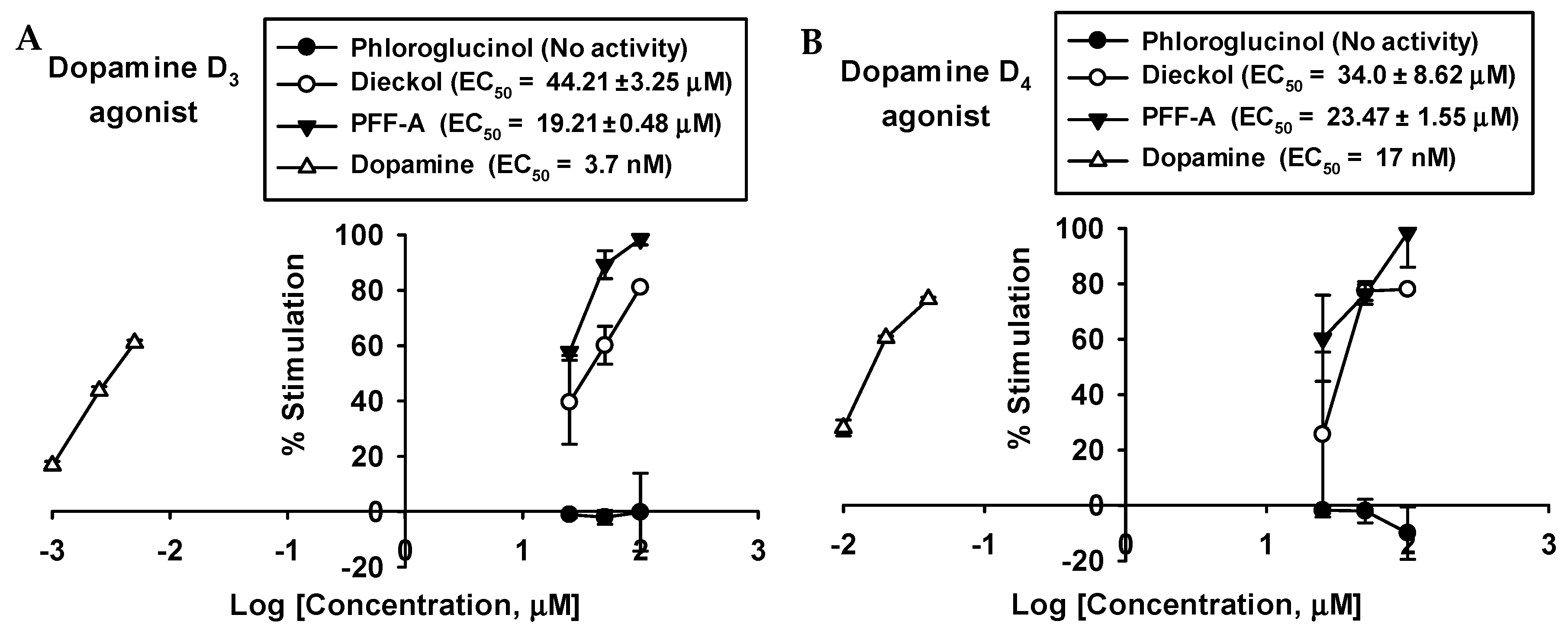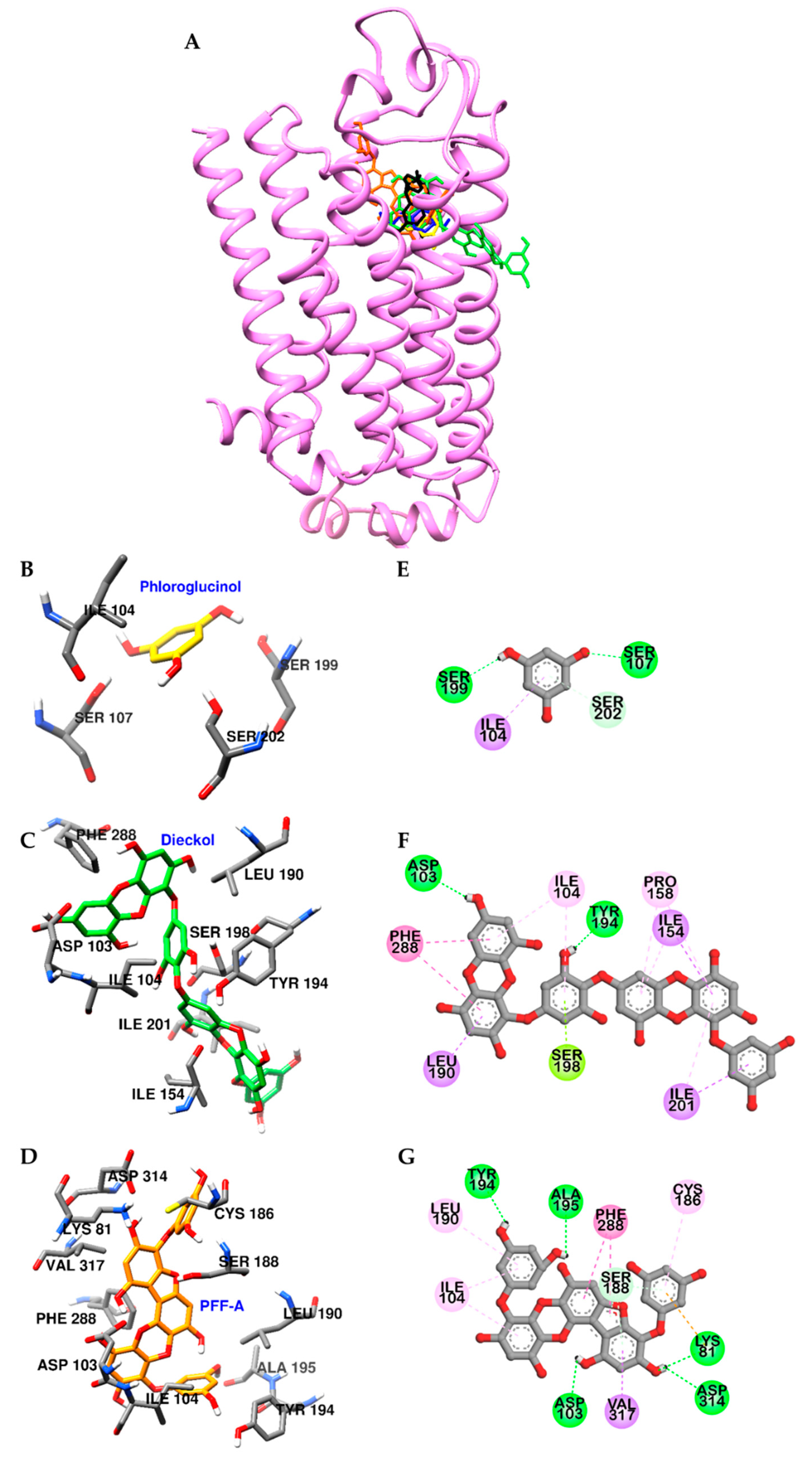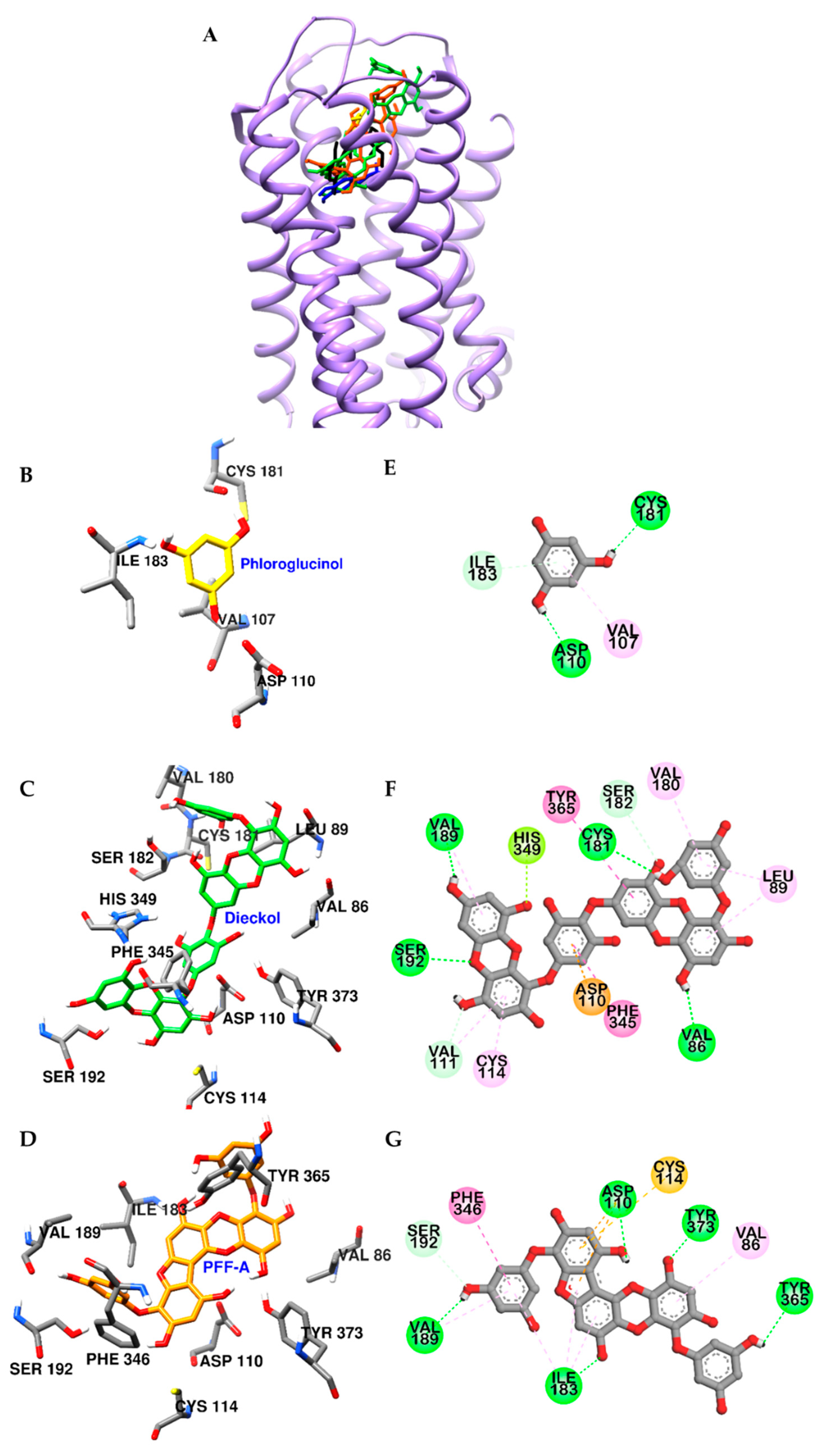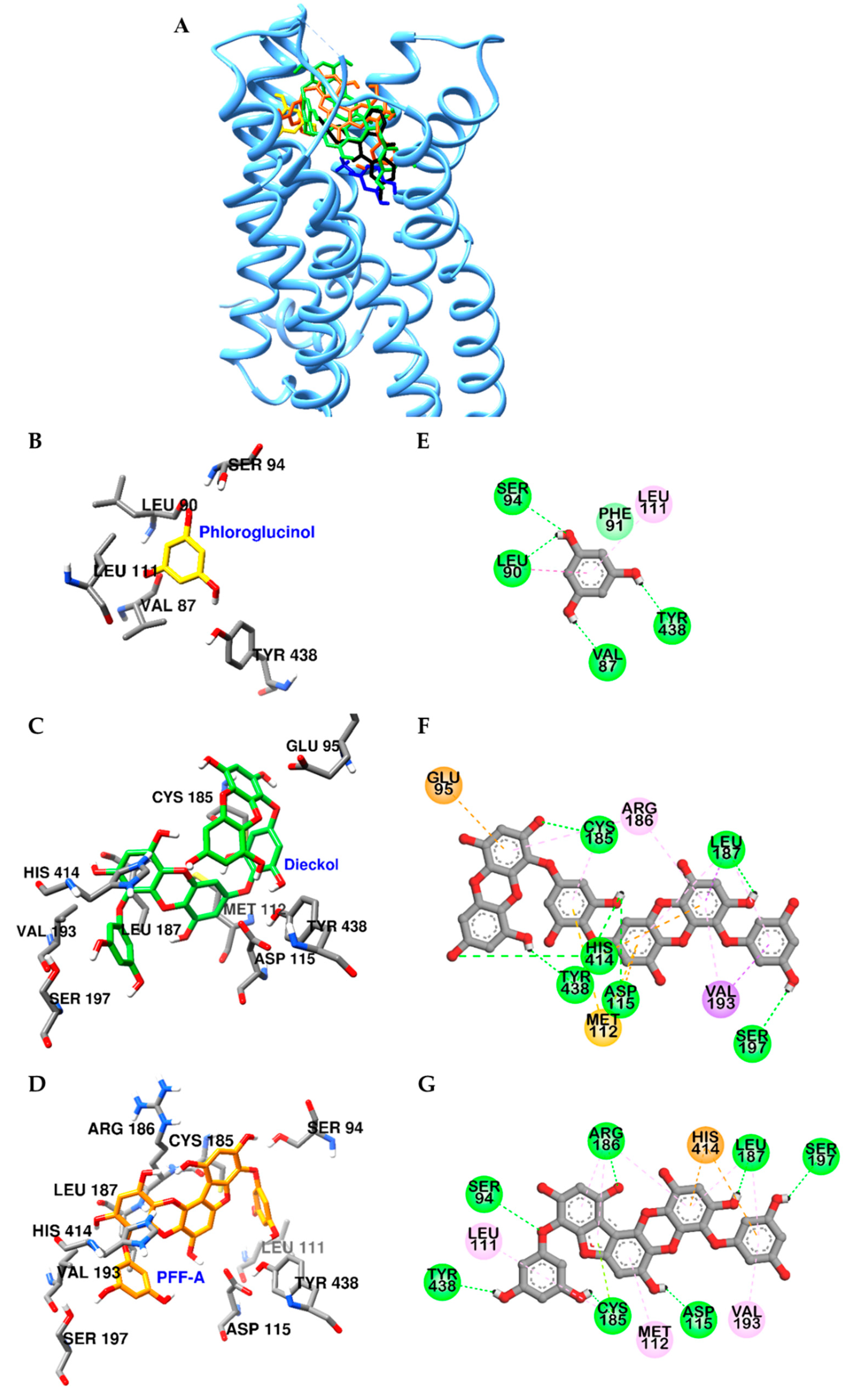Probing Multi-Target Action of Phlorotannins as New Monoamine Oxidase Inhibitors and Dopaminergic Receptor Modulators with the Potential for Treatment of Neuronal Disorders
Abstract
1. Introduction
2. Results
2.1. In Vitro hMAO-A and -B Inhibitory Activities of Phlorotannins
2.2. Kinetic Parameters Toward hMAO-A and -B Inhibition
2.3. In Silico Docking Simulation of PFF-A on hMAOs
2.4. Functional Assay for GPCR Screening
2.5. In Silico Docking Simulation of Phlorotannins on Dopamine Receptors
3. Discussion
4. Materials and Methods
4.1. Chemicals and Reagents
4.2. Isolation of Phlorotannins
4.3. In Vitro hMAO-A and -B Enzyme Assay and Kinetic Analysis
4.4. Functional Assay for GPCR Screening
4.5. Measurement of cAMP Level
4.6. Measurement of Intracellular Ca2+ Level
4.7. Homology Modelling
4.8. In Silico Docking Simulation
4.9. Statistical Analysis
Supplementary Materials
Author Contributions
Funding
Conflicts of Interest
References
- Evrard, A.; Malagie, I.; Laporte, A.M.; Boni, C.; Hanoun, N.; Trillat, A.C.; Seif, I.; De Maeyer, E.; Gardier, A.; Hamon, M.; et al. Altered regulation of the 5-HT system in the brain of MAO-A knock-out mice. Eur. J. Neurosci. 2002, 15, 841–851. [Google Scholar] [CrossRef] [PubMed]
- Finberg, J.P.M.; Rabey, J.M. Inhibitors of MAO-A and MAO-B in psychiatry and neurology. Front. Pharmacol. 2016, 7, 340. [Google Scholar] [CrossRef] [PubMed]
- Ramsay, R.R.; Albreht, A. Kinetics, mechanism, and inhibition of monoamine oxidase. J. Neural. Transm. (Vienna) 2018, 125, 1659–1683. [Google Scholar] [CrossRef] [PubMed]
- Sharp, T.; Gartside, S.E.; Umbers, V. Effects of co-administration of a monoamine oxidase inhibitor and a 5-HT1A receptor antagonist on 5-hydroxytryptamine cell firing and release. Eur. J. Pharmacol. 1997, 320, 15–19. [Google Scholar] [CrossRef]
- Newman, A.H.; Beuming, T.; Banala, A.K.; Donthamsetti, P.; Pongetti, K.; LaBounty, A.; Levy, B.; Cao, J.; Michino, M.; Luedtke, R.R.; et al. Molecular determinants of selectivity and efficacy at the dopamine D3 receptor. J. Med. Chem. 2012, 55, 6689–6699. [Google Scholar] [CrossRef] [PubMed]
- Butini, S.; Nikolic, K.; Kassel, S.; Brückmann, H.; Filipic, S.; Agbaba, D.; Gemma, S.; Brogi, S.; Brindisi, M.; Campiani, G.; et al. Polypharmacology of dopamine receptor ligands. Prog. Neurobiol. 2016, 142, 68–103. [Google Scholar] [CrossRef] [PubMed]
- Bello, F.D.; Ambrosini, D.; Bonifazi, A.; Newman, A.H.; Keck, T.M.; Giannella, M.; Giorgioni, G.; Piergentili, A.; Cappellacci, L.; Cilia, A.; et al. Multitarget 1,4-dioxane compounds combining favorable D2-like and 5-HT1A receptor interactions with potential for the treatment of Parkinson’s disease or schizophrenia. ACS Chem. Neurosci. 2019, 10, 2222–2228. [Google Scholar] [CrossRef]
- Keck, T.M.; Free, R.B.; Day, M.M.; Brown, S.L.; Maddaluna, M.S.; Fountain, G.; Cooper, C.; Fallon, B.; Holmes, M.; Stang, C.T.; et al. Dopamine D4 receptor-selective compounds reveal structure–activity relationships that engender agonist efficacy. J. Med. Chem. 2019, 62, 3722–3740. [Google Scholar] [CrossRef]
- Bourne, J.A. SCH 23390: the first selective dopamine D1-like receptor antagonist. CNS Drug Rev. 2001, 7, 399–414. [Google Scholar] [CrossRef]
- Li, Y.X.; Wijesekara, I.; Li, Y.; Kim, S.K. Phlorotannins as bioactive agents from brown algae. Process. Biochem. 2011, 46, 2219–2224. [Google Scholar] [CrossRef]
- Kim, A.R.; Shin, T.S.; Lee, M.S.; Park, J.Y.; Park, K.E.; Yoon, N.Y.; Kim, J.S.; Choi, J.S.; Jang, B.C.; Byun, D.S.; et al. Isolation and identification of phlorotannins from Ecklonia stolonifera with antioxidant and anti-inflammatory properties. J. Agric. Food Chem. 2009, 57, 3483–3489. [Google Scholar] [CrossRef] [PubMed]
- Artan, M.; Li, Y.; Karadeniz, F.; Lee, S.H.; Kim, M.M.; Kim, S.K. Anti-HIV-1 activity of phloroglucinol derivative, 6,6′-bieckol, from Ecklonia cava. Bioorg. Med. Chem. 2008, 16, 7921–7926. [Google Scholar] [CrossRef] [PubMed]
- Kim, E.K.; Tang, Y.; Kim, Y.S.; Hwang, J.W.; Choi, E.J.; Lee, J.H.; Lee, S.H.; Jeon, Y.J.; Park, P.J. First evidence that Ecklonia cava-derived dieckol atenuates MCF-7 human breast carcinoma cell migration. Mar. Drugs 2015, 13, 1785–1797. [Google Scholar] [CrossRef] [PubMed]
- Sugiura, Y.; Matsuda, K.; Yamada, Y.; Nishikawa, M.; Shioya, K.; Katsuzaki, H.; Imai, K.; Amano, H. Isolation of a new anti-allergic phlorotannin, phlorofucofuroeckol-B from an edible brown alga, Eisenia arborea. Biosci. Biotechnol. Biochem. 2006, 70, 2807–2811. [Google Scholar] [CrossRef] [PubMed]
- Heo, S.J.; Ko, S.C.; Cha, S.H.; Kang, D.H.; Park, H.S.; Choi, Y.U.; Kim, D.; Jung, W.K.; Jeon, Y.J. Effect of phlorotannins isolated from Ecklonia cava on melanogenesis and their protective effect against photo-oxidative stress induced by UV-B radiation. Toxicol. In Vitro 2009, 23, 1123–1130. [Google Scholar] [CrossRef] [PubMed]
- Wang, J.; Zheng, J.; Huang, C.; Zhao, J.; Lin, J.; Zhou, X.; Naman, C.B.; Wang, N.; Gerwick, W.H.; Wang, Q.; et al. Eckmaxol, a Phlorotannin Extracted from Ecklonia maxima, produces anti-β-amyloid oligomer neuroprotective effects possibly via directly acting on glycogen synthase kinase 3β. ACS Chem. Neurosci. 2018, 9, 1349–1356. [Google Scholar] [CrossRef] [PubMed]
- Ryu, J.; Zhang, R.; Hong, B.H.; Yang, E.J.; Kang, K.A.; Choi, M.; Kim, C.; Noh, S.J.; Kim, H.S.; Lee, N.H.; et al. Phloroglucinol attenuates motor functional deficits in an animal model of Parkinson’s disease by enhancing Nrf2 activity. PLoS ONE 2013, 8, e71178. [Google Scholar] [CrossRef] [PubMed]
- Cha, S.H.; Heo, S.J.; Jeon, Y.J.; Park, S.M. Dieckol, an edible seaweed polyphenol, retards rotenone-induced neurotoxicity and α-synuclein aggregation in human dopaminergic neuronal cells. RSC Adv. 2016, 6, 110040–110046. [Google Scholar] [CrossRef]
- Jung, H.A.; Oh, S.H.; Choi, J.S. Molecular docking studies of phlorotannins from Eisenia bicyclis with BACE1 inhibitory activity. Bioorg. Med. Chem. Lett. 2010, 20, 3211–3215. [Google Scholar] [CrossRef]
- Yoon, N.; Chung, H.Y.; Kim, H.R.; Choi, J.S. Acetyl- and butyrylcholinesterase inhibitory activities of sterols and phlorotannins from Ecklonia stolonifera. Fish Sci. 2008, 74, 200–207. [Google Scholar] [CrossRef]
- Cho, S.; Yang, H.; Jeon, Y.J.; Lee, C.J.; Jin, Y.H.; Baek, N.I.; Kim, D.; Kang, S.M.; Yoon, M.; Yong, H.; et al. Phlorotannins of the edible brown seaweed Ecklonia cava Kjellman induce sleep via positive allosteric modulation of gamma-aminobutyric acid type A–benzodiazepine receptor: A novel neurological activity of seaweed polyphenols. Food Chem. 2012, 132, 1133–1142. [Google Scholar] [CrossRef] [PubMed]
- Jung, H.A.; Roy, A.; Jung, J.H.; Choi, J.S. Evaluation of the inhibitory effects of eckol and dieckol isolated from edible brown alga Eisenia bicyclis on human monoamine oxidases A and B. Arch. Pharm. Res. 2017, 40, 480–491. [Google Scholar] [CrossRef] [PubMed]
- Paudel, P.; Seong, S.H.; Wu, S.; Park, S.; Jung, H.A.; Choi, J.S. Eckol as a Potential Therapeutic against Neurodegenerative diseases targeting dopamine D3/D4 receptors. Mar. Drugs 2019, 17, 108. [Google Scholar] [CrossRef]
- Monte, C.D.; Carradori, S.; Chimenti, P.; Secci, D.; Mannina, L.; Alcaro, F.; Petzer, A.; N’Da, C.I.; Gidaro, M.C.; Costa, G.; et al. New insights into the biological properties of Crocus sativus L.: chemical modifications, human monoamine oxidases inhibition and molecular modeling studies. Eur. J. Med. Chem. 2014, 82, 164–171. [Google Scholar] [CrossRef]
- Jaiteh, M.; Zeifman, A.; Saarinen, M.; Svenningsson, P.; Brea, J.; Loza, M.I.; Carlsson, J. Docking screens for dual inhibitors of disparate drug targets for Parkinson’s disease. J. Med. Chem. 2018, 61, 5269–5278. [Google Scholar] [CrossRef] [PubMed]
- Cavalli, A.; Bolognesi, M.L.; Minarini, A.; Rosini, M.; Tumiatti, V.; Recanatini, M.; Melchiorre, C. Multi-target-directed ligands to combat neurodegenerative diseases. J. Med. Chem. 2008, 51, 347–372. [Google Scholar] [CrossRef]
- Huang, C.; Zhang, Z.; Cui, W. Marine-derived natural compounds for the treatment of Parkinson’s disease. Mar. Drugs 2019, 17, 221. [Google Scholar] [CrossRef]
- Garcia-Recio, S.; Gascon, P. Biological and pharmacological aspects of the NK1-receptor. Biomed. Res. Int. 2015, 2015, 495704. [Google Scholar] [CrossRef]
- Egashira, N.; Tanoue, A.; Matsuda, T.; Koushi, E.; Harada, S.; Takano, Y.; Tsujimoto, G.; Mishima, K.; Iwasaki, K.; Fujiwara, M. Impaired social interaction and reduced anxiety-related behavior in vasopressin V1a receptor knockout mice. Behav. Brain Res. 2007, 178, 123–127. [Google Scholar] [CrossRef]
- Rupniak, N.M.J.; Carlson, E.J.; Webb, J.K.; Harrison, T.; Porsolt, R.D.; Roux, S.; de Felipe, C.; Hunt, S.P.; Oates, B.; Wheeldon, A. Comparison of the phenotype of NK1R-/- mice with pharmacological blockade of the substance P (NK1) receptor in assays for antidepressant and anxiolytic drugs. Behav. Pharmacol. 2001, 12, 497–508. [Google Scholar] [CrossRef]
- Kwak, J.H.; Yang, Z.; Yoon, B.; He, Y.; Uhm, S.; Shin, H.C.; Lee, B.H.; Yoo, Y.C.; Lee, K.B.; Han, S.Y.; et al. Blood-brain barrier-permeable fluorone-labeled dieckols acting as neuronal ER stress signaling inhibitors. Biomaterials 2015, 61, 52–60. [Google Scholar] [CrossRef]
- Goo, H.R.; Choi, J.S.; Na, D.H. Quantitative determination of major phlorotannins in Ecklonia stolonifera. Arch. Pharm. Res. 2010, 33, 539–544. [Google Scholar] [CrossRef] [PubMed]
- Seong, S.H.; Ha, M.T.; Min, B.S.; Jung, H.A.; Choi, J.S. Moracin derivatives from Morus Radix as dual BACE1 and cholinesterase inhibitors with antioxidant and anti-glycation capacities. Life Sci. 2018, 210, 20–28. [Google Scholar] [CrossRef] [PubMed]
- Kołaczkowski, M.; Bucki, A.; Feder, M.; Pawłowski, M. Ligand-optimized homology models of D₁ and D₂ dopamine receptors: application for virtual screening. J. Chem. Inf. Model 2013, 53, 638–648. [Google Scholar] [CrossRef]
- Xu, D.; Zhang, Y. Improving the physical realism and structural accuracy of protein models by a two-step atomic-level energy minimization. Biophys. J. 2011, 101, 2525–2534. [Google Scholar] [CrossRef] [PubMed]
- Goodsell, D.S.; Morris, G.M.; Olson, A.J. Automated docking of flexible ligands: applications of AutoDock. J. Mol. Recognit. 1996, 9, 1–5. [Google Scholar] [CrossRef]
- Son, S.Y.; Ma, J.; Kondou, Y.; Yoshimura, M.; Yamashita, E.; Tsukihara, T. Structure of human monoamine oxidase A at 2.2-Å resolution: The control of opening the entry for substrates/inhibitors. Proc. Natl. Acad. Sci. USA 2008, 105, 5739–5744. [Google Scholar] [CrossRef]
- De Colibus, L.; Li, M.; Binda, C.; Lustig, A.; Edmondson, D.E.; Mattevi, A. Three-dimensional structure of human monoamine oxidase a (Mao A): relation to the structures of rat Mao a and human Mao B. Proc. Natl. Acad. Sci. USA 2005, 102, 12864. [Google Scholar] [CrossRef]
- Chien, E.Y.; Liu, W.; Zhao, Q.; Katritch, V.; Han, G.W.; Hanson, M.A.; Shi, L.; Newman, A.H.; Javitch, J.A.; Cherezov, V. Structure of the human dopamine D3 receptor in complex with a D2/D3 selective antagonist. Science 2010, 330, 1091–1095. [Google Scholar] [CrossRef] [PubMed]
- Wang, S.; Wacker, D.; Levit, A.; Che, T.; Betz, R.M.; McCorvy, J.D.; Venkatakrishnan, A.; Huang, X.P.; Dror, R.O.; Shoichet, B.K. D4 dopamine receptor high-resolution structures enable the discovery of selective agonists. Science 2017, 358, 381–386. [Google Scholar] [CrossRef]








| Samples | IC50 (μM) a | SI b | Inhibition Type, Ki Value (µM) | ||
|---|---|---|---|---|---|
| hMAO-A | hMAO-B | hMAO-A | hMAO-B | ||
| Phloroglucinol | >900 | >900 | – | – | – |
| Eckol c | 7.20 ± 0.71 | 83.44 ± 1.48 | 0.09 | Mixed, 20.26 | NC, 162.8 |
| Dioxinodehydroeckol | >300 | >300 | – | – | – |
| Dieckol c | 11.43 ± 1.06 | 43.42 ± 0.73 | 0.26 | NC, 20.28 | NC, 18.50 |
| PFF-A | 9.22 ± 0.19 | 4.89 ± 0.32 | 1.89 | NC, 5.18 | NC, 2.69 |
| R-(‒)-Deprenyl HCl d | 6.76 ± 0.25 | 0.18 ± 0.01 | 88.5 | – | – |
| Ligands | B-energy (kcal/mol) | H-Bond Interacting Residues | Other Interacting Residues |
|---|---|---|---|
| hMAO-A (2Z5X) | |||
| Harmine a | −8.43 b | ‒ | Tyr407 (pi-pi stacked, pi-alkyl), FAD (van der Waals), Cys323 (pi-sulfur), Ile335 (pi-sigma, pi-alkyl), Tyr444, Ile180, Leu337 (pi-Alkyl) |
| PFF-A | −7.71 | Asn92, Gly110, Thr221, Asp338, Lys341 | Lys316 (pi-cation), Lys90, Val93 (pi-sigma), Val93 (amide-pi stacked), Val93, Lys90 (pi-alkyl), Ser94 (van der Waals) |
| hMAO-B (2BYB) | |||
| Deprenyl a | ‒6.34 b | ‒ | Leu171, Ile199 (pi-sigma), Cys172 (pi-sulfur), Tyr326 (pi-pi T-shaped), Tyr398, Tyr435, FAD (pi-alkyl) |
| PFF-A | −7.22 | Ser200, Thr195, Thr196, Asp123, His115, Thr202 | Glu483 (pi-anion), Phe103, Trp119 (pi-pi stacked), Pro102 (pi-alkyl), Arg120 (C-O bond) |
| Receptors (Gene Name) | % Stimulation a (% Inhibition b) | EC50 c (IC50 d) | ||
|---|---|---|---|---|
| Phloroglucinol | Dieckol | PFF-A | Positive Controls | |
| hD1 | 0.20 ± 3.82 A | 1.05 ± 0.21 A | 0.25 ± 3.18 A | 43 |
| (DRD1) | (4.95 ± 3.75) C | (60.60 ± 2.97) B | (81.40 ± 1.41) A | (1.3) |
| hD3 | −0.15 ± 14.07 C | 81.10 ± 0.66 B | 98.57 ± 2.14 A | 3.7 |
| (DRD3) | (−6.75 ± 0.64) A | (−2.50 ± 4.81) A | (−15.20 ± 2.55) B | (31) |
| hD4 | −9.95 ± 14.50 C | 74.43 ± 6.37 B | 98.50 ± 12.50 A | 17 |
| (DRD4) | (−7.05 ± 8.27) A | (−5.35 ± 27.51) A | (−26.05 ± 2.76) A | (120) |
| hM5 | −6.05 ± 0.78 B | 7.60 ± 17.11 AB | 29.20 ± 10.75 A | 1.3 |
| (CHRM5) | (−21.60 ± 8.63) C | (19.55 ± 15.06) B | (56.05 ± 7.00) A,* | (2.2) |
| hNK1 | −0.85 ± 0.21 C | 54.70 ± 1.41 B | 67.65 ± 9.26 A | 0.14 |
| (TACR1) | (−8.05 ± 5.30) B | (77.70 ± 4.95) A,* | (88.20 ± 2.08) A,* | (1.6) |
| h5-HT1A | 0.10 ± 0.28 B | 1.75 ± 0.64 A | 1.65 ± 0.49 A | 2.5 |
| (HTR1A) | (−4.15 ± 0.78) B | (76.80 ± 1.27) A | (62.55 ± 23.26) A | (5.7) |
| hV1A | −0.80 ± 0.57 C | 64.20 ± 0.14 A | 38.45 ± 7.14 B | 0.25 |
| (AVPR1A) | (13.90 ± 6.93) B | (46.20 ± 4.81) A | (52.90 ± 1.56) A,* | (5.5) |
© 2019 by the authors. Licensee MDPI, Basel, Switzerland. This article is an open access article distributed under the terms and conditions of the Creative Commons Attribution (CC BY) license (http://creativecommons.org/licenses/by/4.0/).
Share and Cite
Seong, S.H.; Paudel, P.; Choi, J.-W.; Ahn, D.H.; Nam, T.-J.; Jung, H.A.; Choi, J.S. Probing Multi-Target Action of Phlorotannins as New Monoamine Oxidase Inhibitors and Dopaminergic Receptor Modulators with the Potential for Treatment of Neuronal Disorders. Mar. Drugs 2019, 17, 377. https://doi.org/10.3390/md17060377
Seong SH, Paudel P, Choi J-W, Ahn DH, Nam T-J, Jung HA, Choi JS. Probing Multi-Target Action of Phlorotannins as New Monoamine Oxidase Inhibitors and Dopaminergic Receptor Modulators with the Potential for Treatment of Neuronal Disorders. Marine Drugs. 2019; 17(6):377. https://doi.org/10.3390/md17060377
Chicago/Turabian StyleSeong, Su Hui, Pradeep Paudel, Jeong-Wook Choi, Dong Hyun Ahn, Taek-Jeong Nam, Hyun Ah Jung, and Jae Sue Choi. 2019. "Probing Multi-Target Action of Phlorotannins as New Monoamine Oxidase Inhibitors and Dopaminergic Receptor Modulators with the Potential for Treatment of Neuronal Disorders" Marine Drugs 17, no. 6: 377. https://doi.org/10.3390/md17060377
APA StyleSeong, S. H., Paudel, P., Choi, J.-W., Ahn, D. H., Nam, T.-J., Jung, H. A., & Choi, J. S. (2019). Probing Multi-Target Action of Phlorotannins as New Monoamine Oxidase Inhibitors and Dopaminergic Receptor Modulators with the Potential for Treatment of Neuronal Disorders. Marine Drugs, 17(6), 377. https://doi.org/10.3390/md17060377






